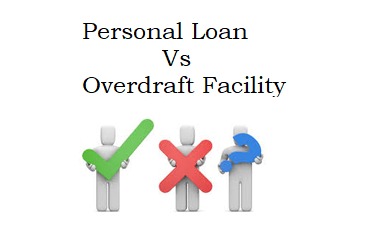While looking to apply for loans, you will come across various financing options. While most people know about personal loans, few are aware of an overdraft facility. It is crucial that you understand the difference between a personal loan and an overdraft account and then decide which one will be suitable for you based on your requirements.
What is a personal loan?
A personal loan is a product where banks or lending institutions lends a certain amount of money to an individual or an entity for a certain period so that the latter can meet their financial requirements.

The loan funds have to be repaid within a certain period on which the bank levies a rate of interest. In most of the cases, the loan applicant may not be required to provide any collateral to avail a personal loan.
What is an overdraft facility?
An overdraft facility is an agreement between the lender and the applicant. The applicant is allowed to withdraw money above the credit limit available in the bank account.

The loan offered is based on the existing balance the account holder has in their bank account.
Difference between a Personal Loan and Overdraft Facility
- Availability
Once banks assign an overdraft facility to an individual, then the amount is readily available to you, and you can withdraw the amount quickly. In contrast, a lot of paperwork and preliminary verifications are required for taking personal loans. To apply for a new personal loan, you have to go through the same application process again. On the other hand, availing overdraft facility is a one-time process which can be modified according to the requirements.
- Prepayment Charges on the Loan
If you plan on repaying a personal loan before the set repayment period, then the bank may levy a prepayment charge on loan. However, there are no prepayment charges levied if you avail an overdraft facility.
- Credit Limit
Under the overdraft facility, different credit limits are assigned to a different borrower. Therefore the applicant can withdraw any required amount within the set limit while in personal loans, the amount being sanctioned is mutually agreed between the bank and the borrower. An individual can’t modify the loan funds after the lender has approved it.
- Interest Rate
The rate of interest levied on overdraft is higher as compared to personal loans. On personal loans, pre-decided interest rates are applied once the personal loan amount is sanctioned. Once the bank approves the personal loan, a percentage of interest which is predetermined is used on the loan amount. In an overdraft facility, if you do not withdraw any amount from your account, there will be no interest charged. However, the interest charged on an overdraft facility is higher as compared to personal loan interest rates. In the case of an overdraft, a credit limit is given, and if an individual doesn’t withdraw from the overdraft limit, then no interest would be charged.
- Mode of Repayment
The mode of repayment for personal loans is through EMI or the format stated by the lender. However, in the case of the overdraft facility, the reimbursement will be at the discretion of the applicant.
Both the products are suitable in their manner and based on your expenses and financial dreams; you are looking to fulfil; you can decide whether you must go for a personal loan or an overdraft facility. For personal loans, you can apply for a Bajaj Finance Personal loan through their online personal loan app. They offer zero hidden charges and 100% transparency in their policies, the personal loan application process is carried out online, and you are allowed to avail loans up to Rs.25 lakhs with tenor options ranging up to 60 months. Also, get pre-approved offers on both secured and unsecured loans such as personal loans, housing loans, business loans and so on.







